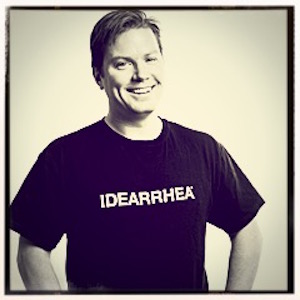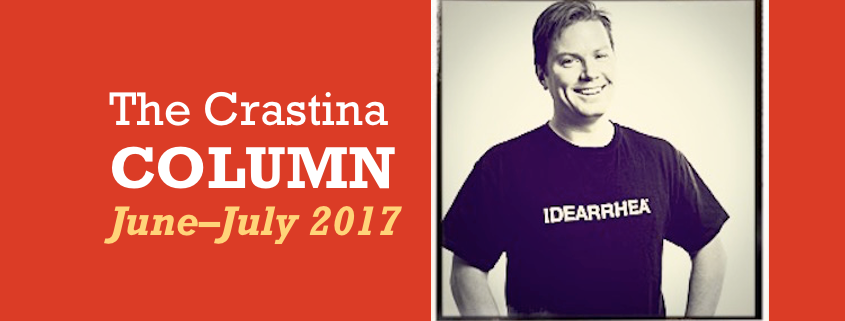Crastina Column, June–Aug 2017: “Being a proud intermediary” by Fredrik Saarkoppel
“I’m specialised in understanding three things: firstly the subject itself, and secondly the perspectives of the two groups that I serve, i.e. senders and receivers.” So says Fredrik Saarkoppel, Swedish freelance illustrator with many clients in academia and the tech industry. This post introduces our summer theme: “Working with the pros”.
 It was a very peculiar situation. I had been studying the illustration before me on the screen for a while – an infographic that should explain the inner workings of CRISPR. Something seemed wrong with it. I compared my sketch to the instructions and graphic outlines that I had been given, but I just couldn’t put my finger on the problem.
It was a very peculiar situation. I had been studying the illustration before me on the screen for a while – an infographic that should explain the inner workings of CRISPR. Something seemed wrong with it. I compared my sketch to the instructions and graphic outlines that I had been given, but I just couldn’t put my finger on the problem.
The strange thing was that the customer didn’t agree with me. She thought the visual explanation worked well.
So, what should I say? I’m only a technical illustrator with a B.Sc. from a university you’ve never heard of. She was the assistant professor and PI from one of my country’s academic flagships. The most diplomatic thing I could come up with was that “I apparently hadn’t understood the process”.
Two hours later she gave me a phone call – and apologized! She had done a mistake. I was right about her being wrong.
This anecdote comes to mind every time I discuss the relationship between experts and professional communicators. Like, for example, when people from academia or R&D departments work with journalists or illustrators. This cooperation sometimes runs very smoothly, and both parts do their best to learn from and to understand the other part. But I have also experienced the opposite: that science people seem to be from Mercury while communication people are from Jupiter.
For a successful communication process, a central prerequisite needs to be fulfilled: the identification of the target audience. And in the case we are talking about here, this audience is neither fully educated peers or uneducated but interested laymen, but a third kind: professionals with an another background and way of seeing things. Sometimes I get the impression that experts have forgotten how it was to not be an expert. Their use of esoteric terms and abstract explanations slows down the exchange of information, very often in an unnecessary way.
As a visual communicator, I must not be discouraged by specialist jargon and expert knowledge; instead, I need to take the lead to get the process going. I know that the best way to help my customer (and eventually their target group) is to trust my own expertise: explaining complex stuff in a concise, structured and appealing way. My observation point as well as my work space are between the sender and the receiver. Through the years, I have seen a lot of different senders presenting all types of content to a wide variety of receivers. Or to put it differently: I am a proud intermediary that has specialized in understanding three things: firstly the subject itself, and secondly the perspectives of the two groups that I serve, i.e. senders and receivers.
Experts in academia and industry have a lot to gain from trusting the skills of professional communicators and become accomplished buyers of such services. It saves time, it saves money, it saves frustration and – especially important! – the end result gets better. The first step to get there is to build a foundation of healthy and mutual respect of both trades. The second step is to practice the art of identifying the target audience which normally varies wildly from nerdy peers to preoccupied members of the public. The third step is to find a common language, without jargon or unnecessary lingo. Personally, I have been fortunate enough to work with people with these abilities.
Fredrik Saarkoppel is a science nerd, designer, illustrator, animator and writer who occasionally is trying innovation. Uncomplicating things through his own business Kobolt Media, situated in Eskilstuna, 120 km west of Stockholm, Sweden.
- Claire Price of Crastina receives outreach award from Royal Society of Biology - October 25, 2020
- Agile Science student project at Brussels Engineering School ECAM: “We can’t wait to try it again!” - August 28, 2020
- Create an infographic in the Lifeology SciArt Infographic Challenge - June 16, 2020
- Adam Ruben – The scientist that teaches undergraduate students comedy - March 27, 2020
- Sam Gregson, Bad Boy of Science: “Comedy helps to bridge the gap” - March 10, 2020
- The Coolest Science Merchandise of 2019 - December 16, 2019
- Science Media Centre (UK) offers guide on dealing with online harassment in academia - November 26, 2019
- Agile project management taught to students and researchers at Karolinska Institutet - September 20, 2019
- Stefan Jansson: Improve your credibility! (Crastina Column, September 2019) - September 6, 2019
- The People’s Poet: Silke Kramprich, tech communicator - August 31, 2019





Leave a Reply
Want to join the discussion?Feel free to contribute!